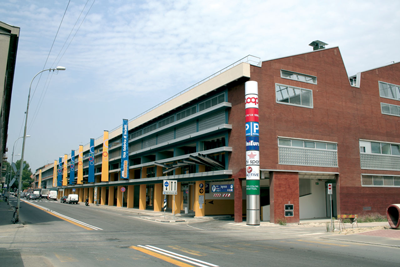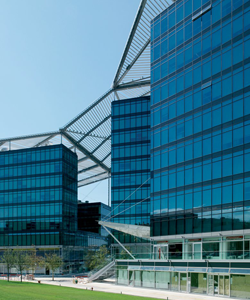You are in: Home page > Magazine > "Beyond the Show"

Gabriele Manella
"Beyond the Show"
Trial and error of urban regeneration in Bolognina
Abstract
In this article, two cases of urban redevelopment in Bologna are considered: the Nuova Sede Unica city hall headquarter and the Officine Minganti shopping mall. Both of them are results of projects for new centralities in Bolognina, a former working-class neighborhood, with the help of “spectacular” architecture, design and marketing elements. Many problems occurred; some of them have been solved while others are still ongoing, especially for Officine Minganti. The article is based on bibliographic analysis, consultation of administrative documents, consultation of websites, interviews with key informants, and direct observation of these settlements.
In this article I consider two cases of urban regeneration in Bolognina: Nuova Sede Unica (the new city hall headquarter) and Officine Minganti (a shopping mall). These are both projects for creating new urban centralities, and the spectacular dimension of some architectural elements is part of this strategy. A number of criticalities emerged, some of which have been solved and some of which are still underway. This article is based on bibliographic analysis, use of administrative documents and websites, interviews with key informants, and direct observation of these settlements.
Bolognina: some statistical and historical data
Bolognina is a 475 hectares northern neighborhood of Bologna, very close to the downtown. The borders are the Bologna ring road on the north, the railway line on the south, Via Stalingrado on the east, and the Navile canal on the west.
There were 35,448 residents in Bolognina on 31st of December 2016. We can see some peculiarities if compared to the rest of the city: a slightly higher rate of young people (26.6% of under 30 residents versus 24.9% in Bologna), a lower rate of elderly (21.5% of over 65 versus 25.4% in Bologna), and many more migrants (25.6% versus 11.2% in Bologna).
These data show that Bolognina as a “working class area”, as we also can see from its history.
Many factories were located there (Scandurra, 2009): Cevolani (1900), Minganti (1919), Casaralta (1919), Acma (1929), and Sasib (1933). However, industrial relocation affected all of them in the 1980s and 1990s. Many disused areas and social degradation problems emerged, as well as the need/opportunity for urban regeneration.
Nuova Sede Unica and Officine Minganti: new centers?
Nuova Sede Unica and Officine Minganti have a brief but troubled history. These projects were already underway during the Giorgio Guazzaloca’s administration (1999-2004), but they were completed during the Sergio Cofferati’s one (2004-2009). A new municipal plan (Comune di Bologna, 2007), introduced the “7 cities” program which also affected Bolognina, with a focus on the area of the former fruit and vegetable market (Mercato Ortofrutticolo).
After a long negotiation between local government and many private actors, Officine Minganti was opened in March 2006 and Nuova Sede Unica was opened in October 2008.
The former is a big crystal complex, with three blocks of different height. A square has been built in the middle of these blocks, below the road level, with a large staircase to access. All municipal offices are located in this complex as well as many commercial services. Nuova Sede Unica has immediately shown a strong spectacular dimension, probably connected to its “regenerative” role; the Hollywood-style opening ceremony is a clear indicator of this. From the very beginning, Nuova Sede Unica has also been characterized by several marketing elements. First, it was a product from the “archistar” Mario Cucinella. Second, the impact of this complex is prominent if compared to other buildings of that area. Third, it has been decorated with “fancy” details, such as Michelangelo Pistoletto’s artwork about Love Difference.
As regards Officine Minganti, the shopping mall took the same name of the factory that was located there. It was the first Bolognina’s industrial site (and the only one so far) to have completed a reconversion process (Collettivo Piano B, 2007). This project focused on the old identity of the factory, as we also can see from the shopping mall’s slogan: “Officine Minganti. Una fabbrica d’incanti” (an enchanting factory). Such slogan resembles a fancy image of shopping mall, more and more frequent in consumption places (Ritzer, 2005) but very little connected to working class culture. Many materials and design solutions, however, are clearly “factory-style”: concrete, glass, steel floors, old laths and cutters exposed in teaks, suspended bridge cranes near the roof and visible from the escalators. This center, however, immediately emerged as disconnected from the surroundings; for example, Chinese retailers were excluded from the mall’s activities while they manage most of local shops and restaurants. If we look it today, Officine Minganti still disappoints expectations. Just six activities are present: three shops, one restaurant, the Virgin gym, and the Coop supermarket. Even the slogan has changed: no more “enchanting factory” but a more sober (but still ambitious) Il centro vitale di Bologna (Bologna’s vital center).
The perception of these places: observation and some interviews
Direct observation showed that Nuova Sede Unica’s services are used much more by commuters and city users (Martinotti, 1993) than residents. This trend was very strong in the early years (Daconto, 2009) but is still going on. Just an example: the Krysstal, a very trendy place for aperitifs and live music, is not very popular for Bolognina’s residents.
Direct observation also confirmed the failure of Officine Minganti: the flow of people is low every day of the week. Shops inside the mall have suffered a very high turnover with just a couple of exceptions: Coop supermarket and Virgin gym. The former, however, is much more expensive than the other gyms in Bolognina.
As regards the interviews with key informants (former administrators, residents, urban planners), there is a clear perception of a radical change in Bolognina. The conflicts of some populations is just a consequence, and it is almost inevitable that places like these are the core of such conflict. This situation probably let us talk about a “contending city” (città contesa) (Bergamaschi, Castrignanò, 2014). People also complain about the impact of Nuova Sede Unica on the local traffic and, more in general, about the lack of a more comprehensive redevelopment project. Officine Minganti is considered a strange mix: it is aimed to enhance the past, but there is almost no affinity with the present of this neighborhood.
Respondents, however, do not give a negative opinion of these settlements. They do not perceive them as a “violence” against their neighborhood, unlike other Bolognina projects (for example, the high speed train works, that caused a vibrant protest from the residents of Via Carracci, adjacent to the railway station).
A critical point, however, is the management of regeneration: everybody asks a greater engagement of local population in this process, as it did not happen in the two cases we have considered.
Nothing beyond the show: conclusions
The spectacular part of these regeneration projects has created a striking contrast, especially in the case of Nuova Sede Unica. On a side, it seems more “successful” than Officine Minganti; on the other side, this success is surrounded by “unconvenient” settlements. First, the social center Xm 24 right next to municipal offices. Second, the former headquarter of Telecom, occupied by almost three hundred people and cleared in October 2015 with many complaints and street conflicts (Capelli et al. 2015). Third, the troubled history of Trilogia Navile, a luxury housing complex just behind Nuova Sede Unica: they started with great ambitions ten years ago, but they still lying among garbage, yards, and controversy by the (few) residents (Capelli, 2016).
The limits of both cases are probably connected to fruition, that clearly advanced social and housing use of space; as a result, an acceptable level of mixitè has not been reached whereas it is a priority in more and more urban regeneration strategies (Castrignanò, 2008). This study suggests that “Bolognina project” was aimed to a new social fabric, that was coming with the gentrification process (Collettivo Piano B, 2008). Most of this area, however, is always the same: even without factories, Bolognina remains a working-class neighborhood for the quality of buildings, the commercial supply and the type of population (Scandurra, 2016). This privatization and commodification of space, however, makes Georg Simmel’s reflections still valid about domination of money economy in the metropolis (1998).
Bibliografia
Bergamaschi, M.; Castrignanò, M. (2018), La città contesa. Popolazioni urbane e spazio pubblico tra coesistenza e conflitto. FrancoAngeli,Milano.
Bignami, S. (2008), Una grande opera firmata Pistoletto. Repubblica - Bologna, 19 giugno
Capelli, E. (2016), Cantieri fantasma e fallimenti: così è svanito il sogno urbanistico del Navile. Repubblica - Bologna, 30 luglio
Capelli, E.; Cori, A.: Giusberti, C.; Venturi, I. (2015). Maxi occupazione a Bologna, sgomberate donne e bambini. Repubblica – Bologna, 20 ottobre
Castrignanò, M. (2008). "Sostenibilità, densità e sviluppo urbano". Sociologia urbana a rurale, 85, 93-103
Collettivo Piano B (2007). "La fabbrica e il dragone Casaralta. Inchiesta sociale su una fabbrica e il suo territorio". Metronomie, 34-35, 43-103
Daconto, L. (2009). Accessibilità urbana. Due studi di caso: a sede unica degli uffici comunali e le Officine Minganti a Bologna. Tesi di Laurea Magistrale in Occupazione Mercato Ambiente, Università di Bologna – Facoltà di Scienze Politiche, anno accademico 2008/2009
Martinotti, G. (1993) Metropoli. La nuova morfologia sociale della città. Il Mulino, Bologna.
Ritzer, G. (2005) La religione dei consumi. Cattedrali, pellegrinaggi e riti dell’iperconsumismo. Il Mulino, Bologna.
Scandurra, G. (2016) "Cosa sarà della Bolognina? Territori in trasformazione". Archivio di studi urbani e regionali, 117, 51-71.
Simmel, G. (1998) Le metropoli e la vita dello spirito. Armando Editore, Roma.
Bignami, S. (2008), Una grande opera firmata Pistoletto. Repubblica - Bologna, 19 giugno
Capelli, E. (2016), Cantieri fantasma e fallimenti: così è svanito il sogno urbanistico del Navile. Repubblica - Bologna, 30 luglio
Capelli, E.; Cori, A.: Giusberti, C.; Venturi, I. (2015). Maxi occupazione a Bologna, sgomberate donne e bambini. Repubblica – Bologna, 20 ottobre
Castrignanò, M. (2008). "Sostenibilità, densità e sviluppo urbano". Sociologia urbana a rurale, 85, 93-103
Collettivo Piano B (2007). "La fabbrica e il dragone Casaralta. Inchiesta sociale su una fabbrica e il suo territorio". Metronomie, 34-35, 43-103
Daconto, L. (2009). Accessibilità urbana. Due studi di caso: a sede unica degli uffici comunali e le Officine Minganti a Bologna. Tesi di Laurea Magistrale in Occupazione Mercato Ambiente, Università di Bologna – Facoltà di Scienze Politiche, anno accademico 2008/2009
Martinotti, G. (1993) Metropoli. La nuova morfologia sociale della città. Il Mulino, Bologna.
Ritzer, G. (2005) La religione dei consumi. Cattedrali, pellegrinaggi e riti dell’iperconsumismo. Il Mulino, Bologna.
Scandurra, G. (2016) "Cosa sarà della Bolognina? Territori in trasformazione". Archivio di studi urbani e regionali, 117, 51-71.
Simmel, G. (1998) Le metropoli e la vita dello spirito. Armando Editore, Roma.
Sitografia
Piano Strutturale Comunale: http://informa.comunebologna.it
Krysstal (bar e ristorante): http://www.krisstal.net
Officine Minganti (centro commerciale): www.officineminganti.it
Repubblica – Edizione di Bologna: http://bologna.repubblica.it
Trilogia Navile: http://www.viveremercatonavile.org/wp/tag/trilogia-navile
Xm 24 (Spazio sociale autogestito): http://www.ecn.org/xm24
Gabriele Manella is associate professor of Urban and Environmental Socology at the University of Bologna, where he is also the secretary of Ce.P.Ci.T. (a research center about urban and territorial problems). As regards his recent pubblications we could mention the editing of the volume "Per una rinascita delle aree interne. Una ricerca nell’Appennino Bolognese" (Angeli, 2017).















